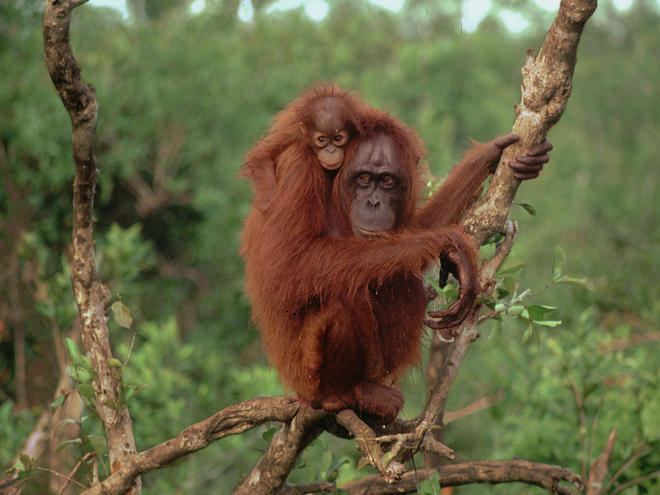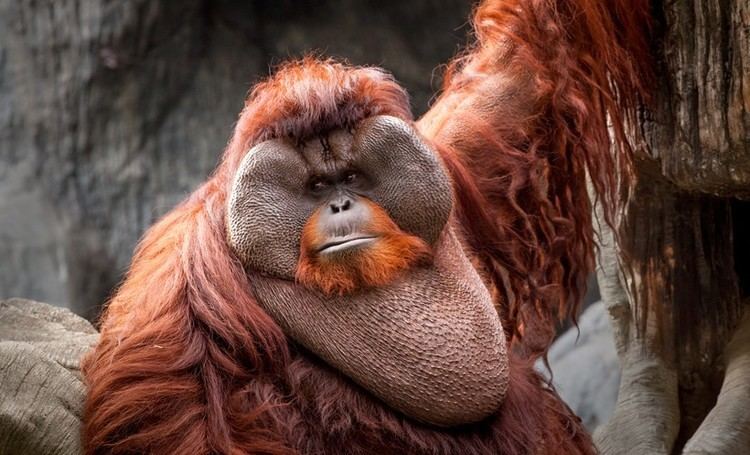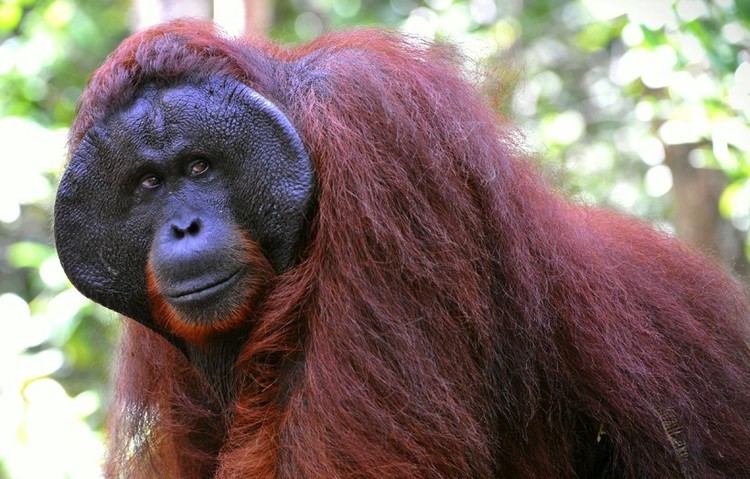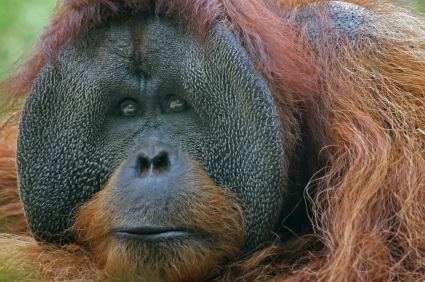Scientific name Pongo pygmaeus Higher classification Orangutan | Phylum Chordata Genus Pongo Rank Species | |
 | ||
Lifespan 35 – 45 years (In the wild) Height Male: 1.2 – 1.4 m (Adult, In the wild), Female: 100 – 120 cm (Adult, In the wild) Mass Male: 50 – 100 kg (Adult, In the wild), Female: 30 – 50 kg (Adult, In the wild) Similar Orangutan, Sumatran orangutan, Primate, Ape, Great apes | ||
Bornean orangutan sumatran orangutan the differences
The Bornean orangutan (Pongo pygmaeus) is a species of orangutan native to the island of Borneo. Together with the Sumatran orangutan, it belongs to the only genus of great apes native to Asia. Like the other great apes, orangutans are highly intelligent, displaying advanced tool use and distinct cultural patterns in the wild. Orangutans share approximately 97% of their DNA with humans.
Contents
- Bornean orangutan sumatran orangutan the differences
- Taxonomy
- Physical description
- Habitat and distribution
- Behavior and ecology
- Diet
- Reproduction
- Conservation status
- Rescue and rehabilitation centers
- Genome
- References

The Bornean orangutan is a critically endangered species, with deforestation, palm oil plantations and hunting posing a serious threat to its continued existence.

Taxonomy

The Bornean orangutan and the Sumatran orangutan diverged about 400,000 years ago, with a continued low level of gene flow between them since then. The two orangutan species were considered merely subspecies until 1996; they were elevated to species following sequencing of their mitochondrial DNA.
The Bornean orangutan has three subspecies:


There is some uncertainty about this, however. The population currently listed as P. p. wurmbii may be closer to the Sumatran orangutan (P. abelii) than to the Bornean orangutan. If this is confirmed, P. abelii would be a subspecies of P. wurmbii (Tiedeman, 1808). In addition, the type locality of P. pygmaeus has not been established beyond doubt; it may be from the population currently listed as P. wurmbii (in which case P. wurmbii would be a junior synonym of P. pygmaeus, while one of the names currently considered a junior synonym of P. pygmaeus would take precedence for the taxon in Sarawak and northern West Kalimantan). Bradon-Jones et al. considered P. morio to be a synonym of P. pygmaeus, and the population found in East Kalimantan and Sabah to be a potentially unnamed separate taxon.

In early October 2014, researchers from domestic and foreign countries found about 50 orangutans separate in several groups in South Kalimantan Province, although previously there is no record that the province has orangutan.
Physical description
The Bornean orangutan is the third-heaviest living primate after the two species of gorilla, and the largest truly arboreal (or tree-dwelling) animal alive today. Body weights broadly overlap with the considerably taller Homo sapiens, but the latter is considerably more variable in size. By comparison, the Sumatran orangutan is similar in size but, on average, is marginally lighter in weight. A survey of wild orangutans found that males weigh on average 75 kg (165 lb), ranging from 50–100 kg (110–220 lb), and 1.2–1.4 m (3.9–4.6 ft) long; females average 38.5 kg (85 lb), ranging from 30–50 kg (66–110 lb), and 1–1.2 m (3.3–3.9 ft) long. While in captivity, orangutans can grow considerably overweight, up to more than 165 kg (364 lb). The heaviest known male orangutan in captivity was an obese male named "Andy", who weighed 204 kg (450 lb) in 1959 when he was 13 years old.
The Bornean orangutan has a distinctive body shape with very long arms that may reach up to 1.5 metres in length. It has a coarse, shaggy, reddish coat and prehensile, grasping hands and feet.
Habitat and distribution
The Bornean orangutan lives in tropical and subtropical moist broadleaf forests in the Bornean lowlands, as well as mountainous areas up to 1,500 metres (4,900 ft) above sea level. This species lives throughout the canopy of primary and secondary forests, and moves large distances to find trees bearing fruit.
It can be found in the two Malaysian states of Sabah and Sarawak, and three of the four Indonesian Provinces of Kalimantan. Due to habitat destruction, the species distribution is now highly patchy throughout the island; the species has become rare in the southeast of the island, as well as in the forests between the Rejang River in central Sarawak and the Padas River in western Sabah.
Behavior and ecology
In history, orangutans ranged throughout Southeast Asia and into southern China, as well as on the island of Java and in southern Sumatra. They primarily inhabit peat swamp forests, tropical health forests, and mixed dipterocarp forests.
Bornean orangutan are more solitary than their Sumatran relatives. Two or three orangutans with overlapping territories may interact, but only for short periods of time. Although orangutans are not territorial, adult males will display threatening behaviors upon meeting other males, and only socialize with females to mate. Males are considered the most solitary of the orangutans. The Bornean orangutan has a lifespan of 35–45 years in the wild; in captivity it can live to be about 60.
Despite being arboreal, the Bornean orangutan travels on the ground more than its Sumatran counterpart. This may be in part because no large terrestrial predators could threaten an orangutan in Borneo. In Sumatra, orangutans must face predation by the fierce Sumatran tiger.
Diet
The Bornean orangutan diet is composed of over 400 types of food, including wild figs, durians, leaves, seeds, bird eggs, flowers, honey, insects, and, to a lesser extent than the Sumatran orangutan, bark. They have also been known to consume the inner shoots of plants and vines. They get the necessary quantities of water from both fruit and from tree holes.
Bornean orangutans have been sighted using spears to attempt (unsuccessfully) to catch fish. The species has been observed using tools such as leaves to wipe off faeces, a pad of leaves for holding spiny durian fruit, a leafy branch for a bee swatter, a bunch of leafy branches held together as an "umbrella" while traveling in the rain, a single stick as backscratcher, and a branch or tree trunk as a missile. And in other regions, orangutans occasionally eat soil to get minerals that may neutralize the toxins and acids they consume in their primarily vegetarian diets. On rare occasions, orangutans will prey upon other, smaller primates, such as slow lorises.
Reproduction
Males and females generally come together only to mate. Subadult males (unflanged) will try to mate with any female and will be successful around half the time. Dominant flanged males will call and advertise their position to receptive females, who prefer mating with flanged males. Adult males will often target females with weaned infants as mating partners because the female is likely to be fertile.
Females reach sexual maturity and experience their first ovulatory cycle between about six and 11 years of age, although females with more body fat may experience this at an earlier age. The estrous cycle lasts between 22 and 30 days and menopause has been reported in captive orangutans at about age 48. Females tend to give birth at about 14–15 years of age. Newborn orangutans nurse every three to four hours, and begin to take soft food from their mothers' lips by four months. During the first year of its life, the young clings to its mother's abdomen by entwining its fingers in and gripping her fur. Offspring are weaned at about four years, but this could be much longer, and soon after they start their adolescent stage of exploring, but always within sight of their mother. During this period, they will also actively seek other young orangutans to play with and travel with.
A 2011 study on female orangutans in free-ranging rehabilitation programs found that individuals that were supplemented with food resources had shorter interbirth intervals, as well as a reduced age, at first birth.
Conservation status
The Bornean orangutan is more common than the Sumatran, with about 54,500 individuals in the wild, whereas about 15,000 Sumatran orangutans are left in the wild. Orangutans are becoming increasingly endangered due to habitat destruction and the bushmeat trade, and young orangutans are captured to be sold as pets, usually entailing the killing of their mothers.
The Bornean orangutan is critically endangered according to the IUCN Red List of mammals, and is listed on Appendix I of CITES. The total number of Bornean orangutans is estimated to be less than 14% of what it was in the recent past (from around 10,000 years ago until the middle of the 20th century), and this sharp decline has occurred mostly over the past few decades due to human activities and development. Species distribution is now highly patchy throughout Borneo; it is apparently absent or uncommon in the southeast of the island, as well as in the forests between the Rejang River in central Sarawak and the Padas River in western Sabah (including the Sultanate of Brunei). A population of around 6,900 is found in Sabangau National Park, but this environment is at risk. According to an anthropologist at Harvard University, in 10 to 20 years, orangutans are expected to be extinct in the wild if no serious effort is made to overcome the threats they are facing.
This view is also supported by the United Nations Environment Programme, which stated in its 2007 report that due to illegal logging, fire and the extensive development of oil palm plantations, orangutans are critically endangered, and if the current trend continues, they will become extinct.
A November 2011 survey, based on interviews with 6,983 respondents in 687 villages across Kalimantan in 2008 to 2009, gave estimated orangutan killing rates of between 750 and 1800 in the year leading up to April 2008. These killing rates were higher than previously thought and confirm that the continued existence of the orangutan in Kalimantan is under serious threat. The survey did not quantify the additional threat to the species due to habitat loss from deforestation and expanding palm-oil plantations. The survey found that 73% of respondents knew orangutans were protected by Indonesian law.
However, the Indonesian government rarely prosecutes or punishes perpetrators. In a rare prosecution in November 2011, two men were arrested for killing at least 20 orangutans and a number of long-nosed proboscis monkeys. They were ordered to conduct the killings by the supervisor of a palm oil plantantion, to protect the crop, with a payment of $100 for a dead orangutan and $22 for a monkey.
Rescue and rehabilitation centers
A number of orangutan rescue and rehabilitation projects operate in Borneo.
The Borneo Orangutan Survival Foundation (BOS) founded by Dr Willie Smits has rescue and rehabilitation centres at Wanariset and Samboja Lestari in East Kalimantan and Nyaru Menteng, in Central Kalimantan founded and managed by Lone Drøscher Nielsen. BOS also works to conserve and recreate the fast-disappearing rainforest habitat of the orangutan, at Samboja Lestari and Mawas.
Orangutan Foundation International, founded by Dr Birutė Galdikas, rescues and rehabilitates orangutans, preparing them for release back into protected areas of the Indonesian rain forest. In addition, it promotes the preservation of the rain forest for them.
The Sepilok Orangutan Rehabilitation Centre near Sandakan in the state of Sabah in Malaysian Borneo opened in 1964 as the first official orangutan rehabilitation project.
A seven-year longitudinal study published in 2011 looked at whether the lifespan of zoo-housed orangutans was related to a subjective assessment of well-being, with the intent of applying such measures to assess the welfare of orangutans in captivity. Of the subjects, 100 were Sumatran (Pongo abelii), 54 Bornean (Pongo pygmaeus) and 30 were hybrid orangutans. 113 zoo employees, who were highly familiar with the typical behavior of the orangutans, used a four-item questionnaire to assess their subjective well-being. The results indicated that orangutans in higher subjective well-being were less likely to die during the follow-up period. The study concluded that happiness was related to longer life in orangutans.
In late 2014, Nyaru Menteng veterinarians failed to rescue the life of a female orangutan. An operation was performed in which 40 air-rifle pellets were removed from her body. The orangutan was found at a palm oil plantation in Indonesian Borneo.
Genome
The genome of the Bornean orangutan is programmed to be sequenced.
